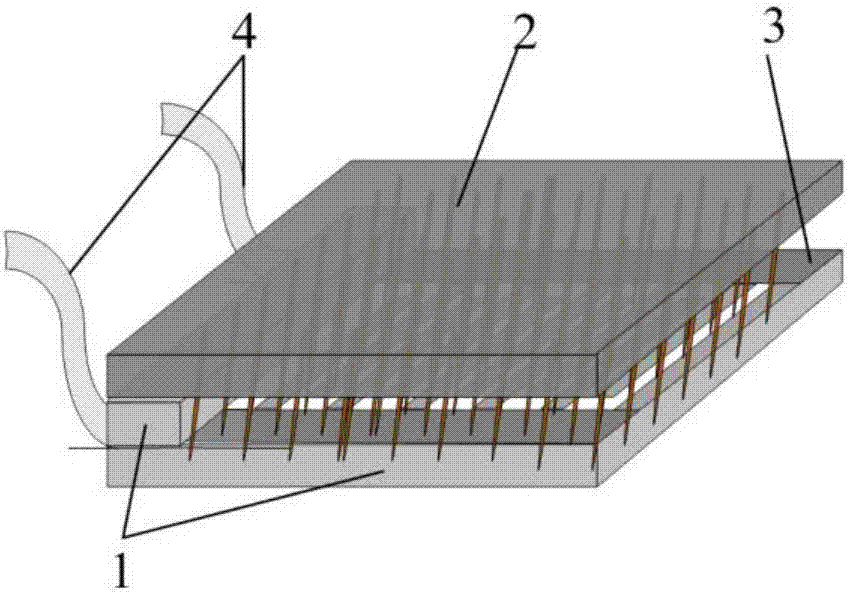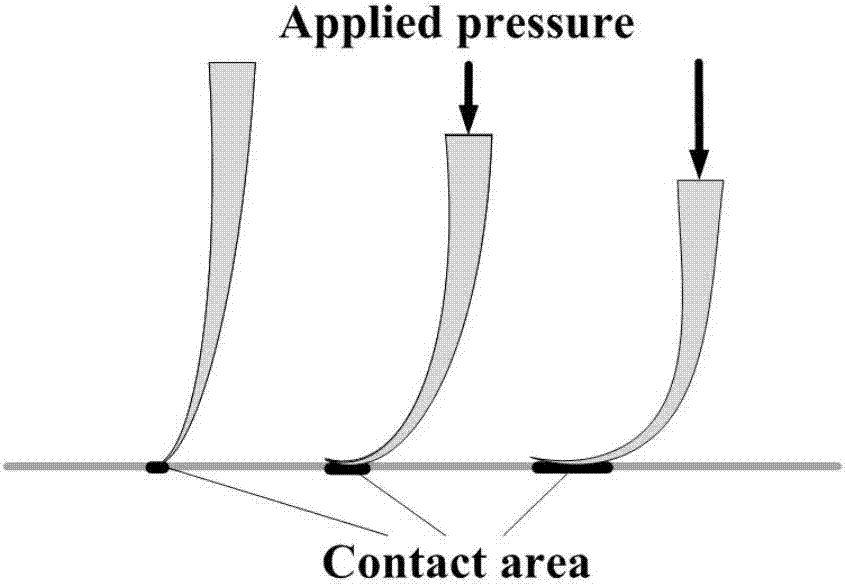Magnetic and force cilium bionic sensor and preparation method thereof
A sensor and cilia technology, applied in the field of flexible sensors, can solve problems such as detecting a single contact force signal, and achieve the effects of good repeatability, low cost and high sensitivity
- Summary
- Abstract
- Description
- Claims
- Application Information
AI Technical Summary
Problems solved by technology
Method used
Image
Examples
Embodiment 1
[0039] Step 1. Add 1.5g of polydimethylsiloxane and 0.2g of cobalt particles with a diameter of 500nm into 15ml of ethyl acetate and stir evenly. After ultrasonication for 0.5min, quickly put the above mixed solution in a 300mT uniform vertical magnetic field environment. Heating at 60°C for 16 hours until the solvent is completely volatilized and the resin is cured to obtain a magnetic cilia array, such as Figure 4 shown.
[0040] Step 2: Soak the above-mentioned magnetic cilia array in a graphene oxide aqueous solution with a concentration of 0.2g / L for 5 minutes, take it out, put it in a uniform vertical magnetic field environment, and heat it at 60°C for 4 hours until it is completely dried.
[0041] Step 3. Put the above-mentioned magnetic cilia array coated with graphene oxide into HI solution, soak at 20°C for 3min, wash with deionized water, and then heat at 60°C for 2h to completely dry to obtain the surface covered with reduced graphite oxide The magnetic cilia arr...
Embodiment 2
[0046] Step 1. Add 2g of polydiethylsiloxane and 0.02g of iron particles with a diameter of 500nm into 20ml of xylene and stir evenly. After ultrasonication for 10 minutes, quickly put the above mixed solution in a uniform vertical magnetic field environment of 500mT. Heating under the conditions for 12 hours until the solvent is completely volatilized and the resin is cured to obtain a magnetic cilia array with a cilia length of 1000 μm.
[0047] Step 2: Soak the above-mentioned magnetic cilia array in a graphene oxide aqueous solution with a concentration of 0.5 g / L for 1 min, take it out, put it in a uniform vertical magnetic field environment, and heat it at 80° C. for 2 h until it is completely dried.
[0048] Step 3. Put the above-mentioned magnetic cilia array coated with graphene oxide into KOH solution, soak at 90°C for 60min, wash with deionized water, and heat at 100°C for 0.5h to completely dry to obtain the surface covered with redox Graphene's array of magnetic c...
Embodiment 3
[0053] Step 1. Add 0.5g of polymethylvinylsiloxane and 0.25g of nickel particles with a diameter of 1000nm into 50ml of toluene and stir evenly. After ultrasonication for 10min, quickly put the above mixed solution in a uniform vertical magnetic field environment of 1000mT. It was heated at ℃ for 20 h until the solvent was completely volatilized and the resin was solidified to obtain a magnetic cilia array with a cilia length of 10000 μm.
[0054] Step 2: Soak the above-mentioned magnetic cilia array in a graphene oxide aqueous solution with a concentration of 0.05g / L for 10 minutes, take it out, put it in a uniform vertical magnetic field environment, and heat it at 80°C for 2 hours until it is completely dried.
[0055] Step 3, repeat step 2 5 times.
[0056] Step 4. Put the above-mentioned magnetic cilia array coated with graphene oxide into hydrazine hydrate solution, soak at 60°C for 600min, wash with deionized water, and then heat at 70°C for 1h to completely dry to obta...
PUM
 Login to View More
Login to View More Abstract
Description
Claims
Application Information
 Login to View More
Login to View More - R&D
- Intellectual Property
- Life Sciences
- Materials
- Tech Scout
- Unparalleled Data Quality
- Higher Quality Content
- 60% Fewer Hallucinations
Browse by: Latest US Patents, China's latest patents, Technical Efficacy Thesaurus, Application Domain, Technology Topic, Popular Technical Reports.
© 2025 PatSnap. All rights reserved.Legal|Privacy policy|Modern Slavery Act Transparency Statement|Sitemap|About US| Contact US: help@patsnap.com



